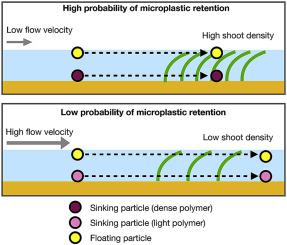Environmental Pollution ( IF 8.9 ) Pub Date : 2020-11-23 , DOI: 10.1016/j.envpol.2020.116050 Carmen B. de los Santos , Anna-Sara Krång , Eduardo Infantes

|
Marine canopies formed by seagrass and other coastal vegetated ecosystems could act as sinks of microplastics for being efficient particle traps. Here we investigated for the first time the occurrence of microplastic retention by marine canopies in a hydraulic flume under unidirectional flow velocities from 2 to 30 cm s-1. We used as model canopy-forming species the seagrass Zostera marina with four canopy shoot density (0, 50, 100, 200 shoots m-2), and we used as microplastic particles industrial pristine pellets with specific densities from 0.90 to 1.34 g cm-3 (polypropylene PP; polystyrene PS; polyamide 6 PA; and polyethylene terephthalate PET). Overall, microplastics particles transported with the flow were retained in the seagrass canopies but not in bare sand. While seagrass canopies retained floating microplastics (PP) only at low velocities (<12 cm s-1) due to a barrier created by the canopy touching the water surface, the retention of sinking particles (PS, PA, PET) occurred across a wider range of flow velocities. Our simulations revealed that less dense sinking particles (PS) might escape from the canopy at high velocities, while denser sinking particles can be trapped in scouring areas created by erosive processes around the eelgrass shoots. Our results show that marine canopies might act as potential barriers or sinks for microplastics at certain bio-physical conditions, with the probability of retention generally increasing with the seagrass shoot density and polymer specific density and decreasing with the flow velocity. We conclude that seagrass meadows, and other aquatic canopy-forming ecosystems, should be prioritized habitats in assessment of microplastic exposure and impact on coastal areas since they may accumulate high concentration of microplastic particles that could affect associated fauna.
中文翻译:

海洋植物冠层的微塑料滞留:水槽内海草草甸的模拟
由海草和其他沿海植被生态系统形成的海洋冠层可以充当微塑料的汇,从而成为有效的粒子陷阱。在这里,我们首次调查了在2至30 cm s -1的单向流速下,水力水槽中的海洋冠层发生微塑性滞留的情况。我们将具有四个树冠芽密度(0、50、100、200芽m -2)的海草Zostera marina用作模型的树冠形成物种,并将其用作密度从0.90到1.34 g cm的工业原始粒料的微塑料颗粒- 3(聚丙烯PP;聚苯乙烯PS;聚酰胺6 PA;和聚对苯二甲酸乙二酯PET)。总体而言,随流运输的微塑料颗粒保留在海草冠层中,而不保留在裸露的沙子中。虽然海草冠层仅在低速(<12 cm s -1)下保留漂浮的微塑料(PP))由于树冠接触水面而形成的障碍,下沉颗粒(PS,PA,PET)的保留在较大的流速范围内均会发生。我们的模拟表明,密度较低的下沉颗粒(PS)可能以较高的速度从树冠中逸出,而密度较高的下沉颗粒则可能被捕获在鳗草芽周围侵蚀过程所形成的擦洗区域中。我们的结果表明,海洋冠层在某些生物物理条件下可能充当微塑料的潜在屏障或汇,其保留概率通常随海草枝条密度和聚合物比重而增加,而随流速而降低。我们得出的结论是,海草草甸和其他形成水生冠层的生态系统



























 京公网安备 11010802027423号
京公网安备 11010802027423号